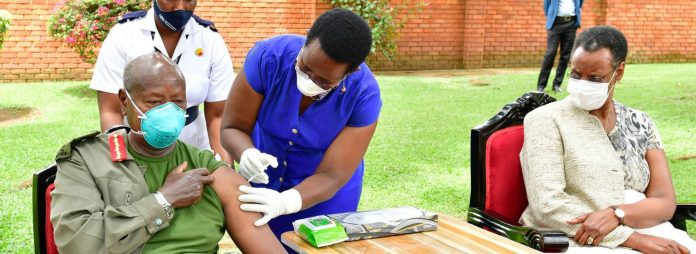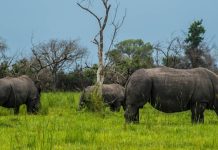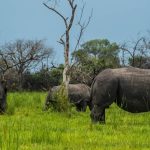On September 22nd 2021, the president of Uganda H.E Yoweri Museveni eased Covid-19 restrictions. During his Address on measures to contain covid-19 situation, Museveni confirmed that Covid-19 transmission rates have continued to decline.
As a result, some of the Covid-19 restrictions were lifted including allowing universities to re-open November this year, increasing vaccination that targets 4.8 million Ugandans. The president also allowed places of worship and entertainment venues to open minus bars. However, curfew time is maintained among other restrictions to prevent a likely outbreak of third wave of covid-19 pandemic.
Covid-19 started in Uganda in March 2020 with Ministry of Health (MOH) Uganda registering its first covid-19 case. The country implemented a total lockdown shut down Entebbe airport and most business, schools, private and public vehicles.
After the first wave of covid-19, Entebbe airport was opened for tourism. But, in May 2021 the country started experiencing a second wave of Covid-19 due to emergency of new highly infectious corona virus variants such as delta variant.
In reaction, the president of Uganda H.E. Yoweri Museveni announced a lockdown for 42 days from June 18th to July, 20th 2021 shutting down public transport, schools and entertainment venues.
The lockdown helped to contain the transmission of covid-19 despite the peak of the second wave. Between June and July, the average confirmed daily had reached 1445 but significantly declined to 124 cases. In addition, the number of death also reduced from 57 to 6 people.
During his latest address on the nation, the president brought up-to-date information on the Covid-19 situation in Uganda. He confirmed that as of September 2021, the registered cases of covid-19 in Uganda stand at 122,502 and 3135 deaths.
Furthermore, the Independent newspaper article published on Wednesday, September 22nd 2021 shows the status of covid-19 patients currently in hospitals. The number of people admitted in public and private hospitals stand at 340 with 272 in public, 66 in prisons and 2 in private facilities. 144 are in intensive care condition which represent 38% of the total number of covid-19 admissions.
With the above numbers, the spread of covid-19 situation in Uganda is stable compared to previous year. However, there are 9 districts likely to have high rate of Covid-19 transmission. These include Kampala, Kalungu, Kabale, Kumi, Soroti, Tororo, Gulu, Nwoya and Yumbe.
The Ministry of Health (MOH) Uganda and the covid-19 response team has identified measures to further contain the spread of new variants and the possible third wave of Covid-19.
The measures include the following apply to all Ugandan in general across the country.
- Increasing Covid-19 vaccination
- Mandatory testing of covid-19 at Entebbe airport and all 53 land border entry points.
- Safe re-opening of schools and other business that have been lockdown
- Maintaining curfew and Standard Operating Procedures (SOP’s).
Covid-19 Vaccination Situation in Uganda 2021.
Uganda received its first batch of 684,000 doses of AstraZeneca vaccine from India early March 2021. The Uganda government has since carried out extensive mobilization campaign and obtained various vaccines approved by the World Health Organization (WHO).
Data from the Ministry of Health (MOH) shows that the type and quantity of vaccines received and the ones expected to arrive in the country before end of 2021 will total to 12 million doses.
Vaccines Received in Uganda
- 1,647,000 doses of Pfizer vaccines were received September 20th 2021 donated by United States of America.
- 647,000 doses of Moderna vaccines from USA September 6th 2021
- 501,000 doses of AstraZaneca vaccine from France arrived on September 22nd 2021.
- 344,900 doses of AstraZaneca from Belgium arrived on September 22nd 2021
- 700,000 doses of Sinovac vaccine from China 30th September
Vaccines Yet to Arrive in Uganda 2021
- 700,000 doses of Sinovac will come from China by end of September 2021
- 3,488,940 doses of Pfizer vaccine from USA by October 2021
- 1,200,000 doses of Johnson & Johnson vaccines will be purchased by Uganda government end of October 2021
- 2,000,000 doses of Sinopharm vaccines will come be bought by Uganda Government end of September 2021.
- 1,000,000 doses of AstraZaneca vaccines from Covax India end of October 2021.
- 350,000 doses of AstraZeneca vaccines shall come from Ireland Mind October 2021.
- 100,000 doses of Jonson & Johnson vaccine shall come from Belgium end of November 2021.
Now with 2,294,000 doses of vaccines administered at Uganda National Medical Stores (NMS), the government aims to vaccinate about 4.8 million people before end of year. Supposing that each person gets two shots, 2.3% of Uganda’s of the 45 million population. Source: World Coronavirus Tracker. The vaccination strategy targets Ugandans aged 18 years and above but not limited to health and security workers, primary and secondary school teachers, elderly persons aged 50 years and above and students in institutions of higher learning.
So far, the vaccination status of the 4.8 million people stands as follows:-
The number of teachers targeted are 550000. Of these, 269,945 (49%) and 96,653 (17.6%) have received their first and second dose respectively. Those unvaccinated first and second dose are 280,055 and 453,347 respectively.
Health workers targeted are 150,000. So far 112,129 (74.8%) have got their first dose while 56,687 (37.8) % their second dose.
In addition to vaccination, there are measures to further prevent the likely outbreak of third wave and emergency of new covid-19 variants like delta. The president directed covid-19 response team and Ministry of Health (MOH) Uganda to do the following:-
- Increase surveillance through implementation of new Covid-19 testing procedures at Entebbe airport and al 54 land borders. So far, there are 15 test fly laboratories accredited to carry out covid-19 testing with six in Entebbe town.
- Installation of new testing facilities
- Enforcing Standard Operating Procedures (SOP’s).
- Hot spot districts mentioned above continue to be monitored for a period of two weeks.
Covid-19 restrictions that were lifted
To safely re-open sectors under lockdown, the covid-19 task force and Ministry of Health (MOH) considers a number of factors such as; risk of transmission, vulnerability of people and impact on the sector. therefore, re-opening of the following is based on National Health Act guidelines and scientific evidence as well as enforcement of SOP’s.
Institutions of higher learning such as universities will re-open November 1st 2021.
Primary and secondary schools shall re-open next year 2022 once the vaccination of teachers, no working staff and 330,000 students in post-secondary institutions aged 18 above is complete.
Places of worship, funerals and weddings are allowed to open along with performing arts and entertainment venues such as casinos, gaming, gyms and shopping halls. However, bars, cinemas, disco clubs, beaches, concerts for performing artists remain closed.
To operate smoothly, these must limit the capacity to 200 people and follow the Standard Operating Procedures such as wearing face masks, maintain social distancing, washing hands with soap and sanitizer.
Curfew time has been maintained to limit movement of people at night. Curfew time starts at 7:00pm up to 5:30am. Motorcycles/ Boda Bodas should stop movement before 7:00pm.
Food markets are fully open except in the 9 districts mentioned above.












